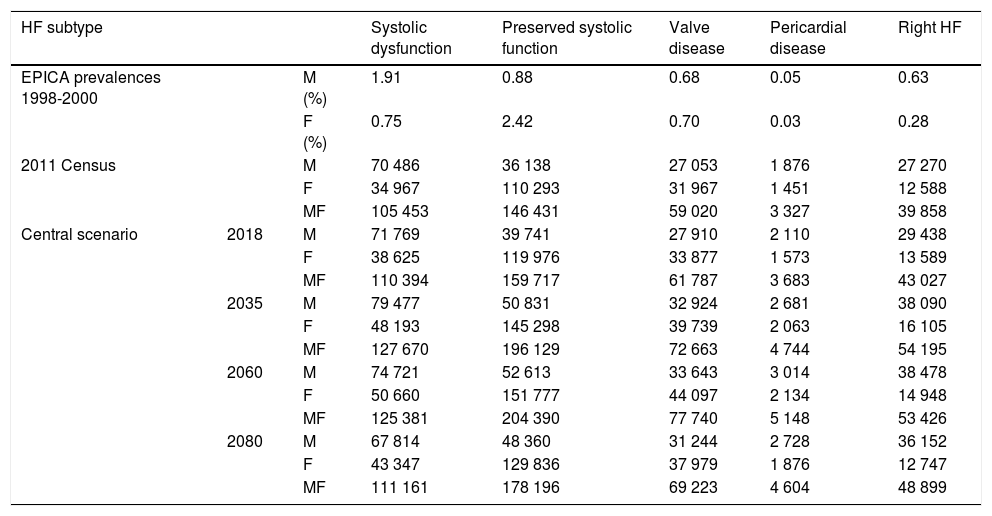In the article “Heart failure in numbers: Estimates for the 21st century in Portugal” Rev Port Cardiol. 2018; 37 (2): 97-104, please consider the following corrections:
- 1)
In the Results section, for the number of individuals affected by the syndrome, “According to the EPICA study, the most common form of HF is HF with preserved systolic function, followed by HF due to systolic dysfunction. It is estimated that 126 898 patients will be suffering from HF with preserved systolic function in 2018. There will be a much higher prevalence among women, 96 762 of whom will have this form of HF in that year. Systolic dysfunction will be more prevalent among men, 65 408, 65 441, 57 769 and 51 381 of whom are likely to be affected by this type of HF in 2018, 2035, 2060 and 2080, respectively”, should read “According to the EPICA study, the most common form of HF is HF with preserved systolic function, followed by HF due to systolic dysfunction. It is estimated that 159 717 patients will be suffering from HF with preserved systolic function in 2018. There will be a much higher prevalence among women, 119 976 of whom will have this form of HF in that year. Systolic dysfunction will be more prevalent among men, 71 769, 79 477, 74 721 and 67 814 of whom are likely to be affected by this type of HF in 2018, 2035, 2060 and 2080, respectively.”
- 2)
In the Results section, for the number of individuals according to NYHA classification, “The number of individuals with HF under the NYHA classification was also estimated (fig. II). Thus, it is expected that 122 781 discharged patients will have NYHA class II HF in 2035, compared to over 136 000 patients who will be classified as class III or IV (fig. II).” should read “The number of individuals with HF according to the New York Heart Association (NYHA) was also estimated. Thus, it is expected that 143 496 discharged patients will be in NYHA class II HF in 2035, compared to over 136 000 patients who will be classified as class III or IV (Figure 2).”
- 3)
In the Discussion section, for the number of individuals affected by the syndrome, “An analysis of the projections by HF subtype indicates that by 2018 there will be 126 898 individuals with HF with preserved systolic function, most of whom will be elderly and female, in agreement with the existing literature.12” should read “An analysis of the projections by HF subtype indicates that by 2018 there will be 159 717 individuals with HF with preserved systolic function, most of whom will be elderly and female, in agreement with the existing literature.12”
- 4)
Table 1 should be replaced as follows:
Table 1.Estimates of absolute numbers of different types of heart failure in the population of mainland Portugal aged over 25 years.
HF subtype Systolic dysfunction Preserved systolic function Valve disease Pericardial disease Right HF EPICA prevalences 1998-2000 M (%) 1.91 0.88 0.68 0.05 0.63 F (%) 0.75 2.42 0.70 0.03 0.28 2011 Census M 70 486 36 138 27 053 1 876 27 270 F 34 967 110 293 31 967 1 451 12 588 MF 105 453 146 431 59 020 3 327 39 858 Central scenario 2018 M 71 769 39 741 27 910 2 110 29 438 F 38 625 119 976 33 877 1 573 13 589 MF 110 394 159 717 61 787 3 683 43 027 2035 M 79 477 50 831 32 924 2 681 38 090 F 48 193 145 298 39 739 2 063 16 105 MF 127 670 196 129 72 663 4 744 54 195 2060 M 74 721 52 613 33 643 3 014 38 478 F 50 660 151 777 44 097 2 134 14 948 MF 125 381 204 390 77 740 5 148 53 426 2080 M 67 814 48 360 31 244 2 728 36 152 F 43 347 129 836 37 979 1 876 12 747 MF 111 161 178 196 69 223 4 604 48 899 Prevalences for individuals in the Portuguese population over 25 years of age, according to HF subtype and gender, are presented for the period 1998-2000 (EPICA study). Projections for the number of individuals in the Portuguese population over 25 years of age, according to HF subtype and gender, are shown for the years 2011, 2018, 2035, 2060 and 2080. The prevalences of multifactorial and unknown classification HF subtypes are not shown. F: female; HF: heart failure; M: male; MF: sum of male and female.
Please cite this article as: Fonseca C, Brás D, Araújo I, Ceia F. Errata a “Insuficiência Cardíaca em números: estimativas para o século XXI em Portugal” . https://doi.org/10.1016/j.repce.2017.11.017.






